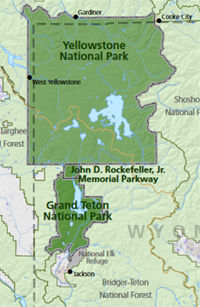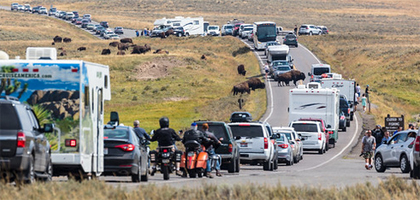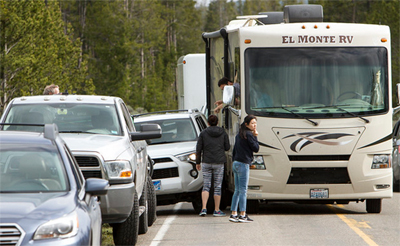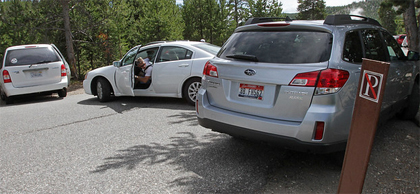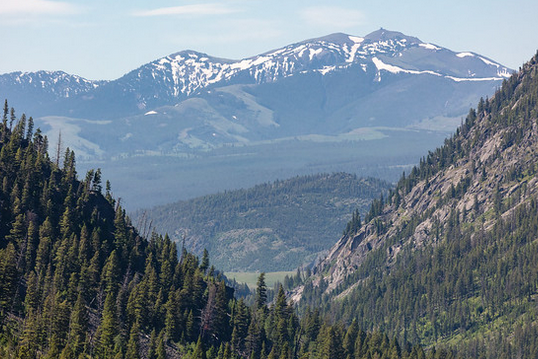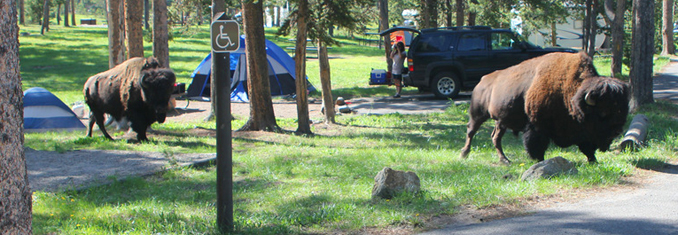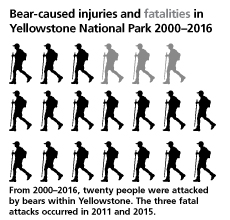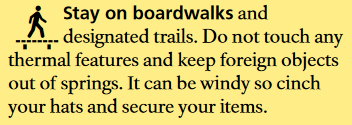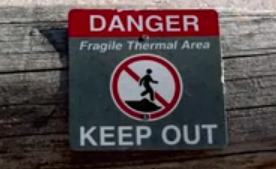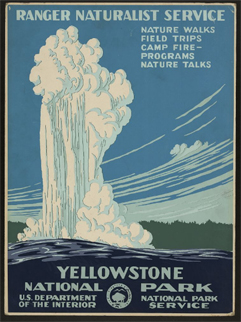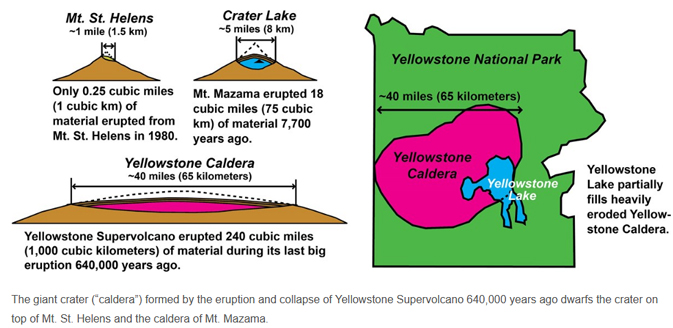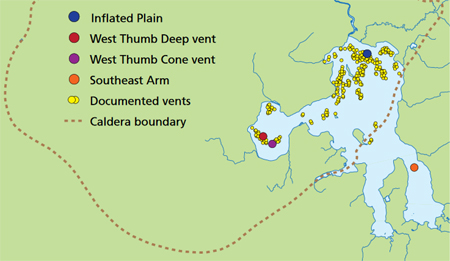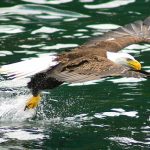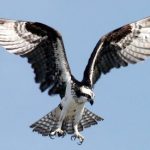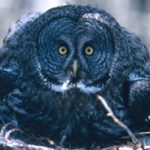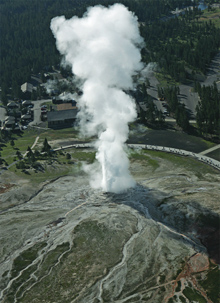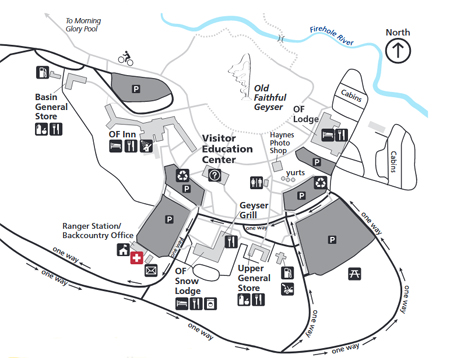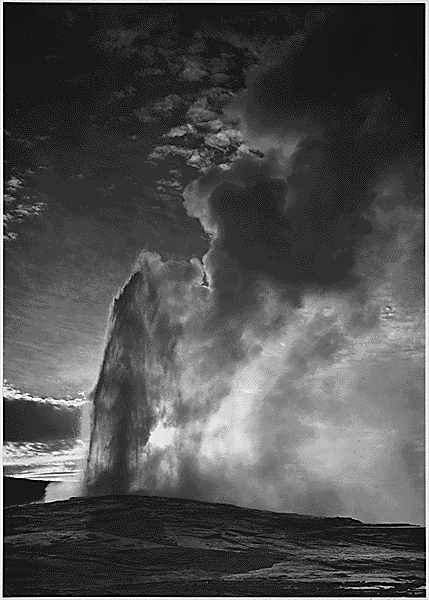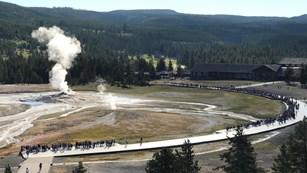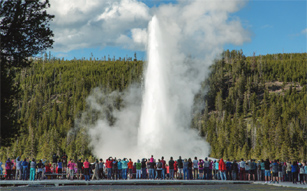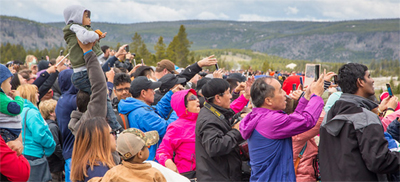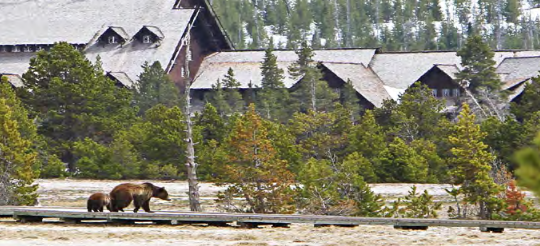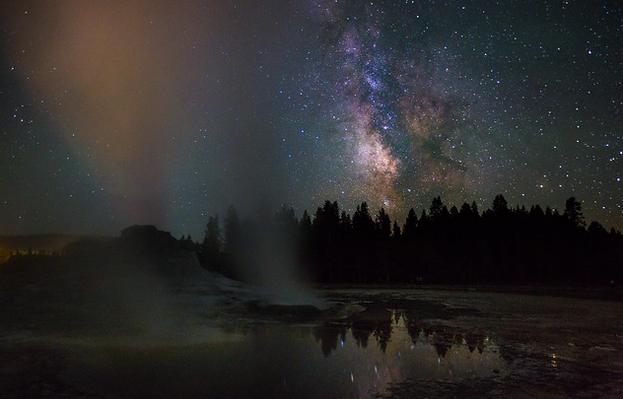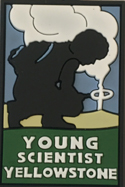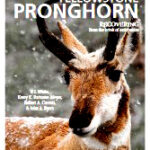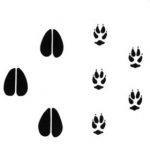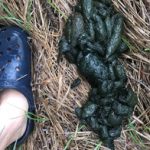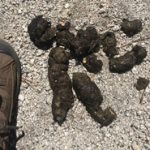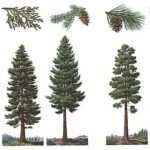![]()
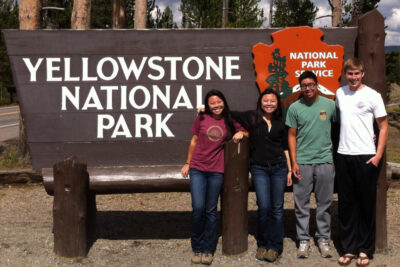
This is additional info on Yellowstone National Park for our Outdoor Club Grand Tetons trip. For our event, any side trip you take to Yellowstone on your own will not be an official club event and the college owned kayaks can’t be used there unless the advisor is along to make it an official trip and we pay extra permit fees.
Below, on the left, a National Park Service aerial view of Yellowstone Park
to the right, in the NASA photo from space the biggest lake in the upper half is Yellowstone Lake, and the long one further south is Jackson Lake, with the Teton range showing as a white snow covered strip to the left of it.
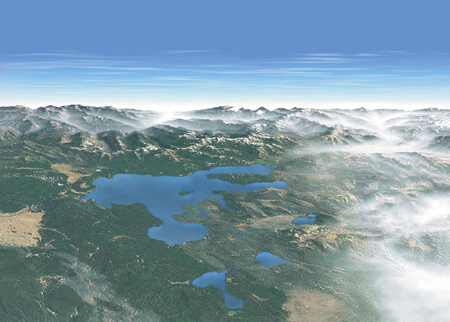
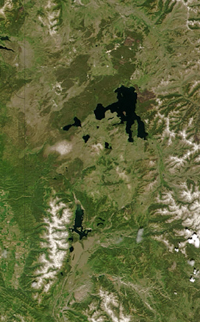
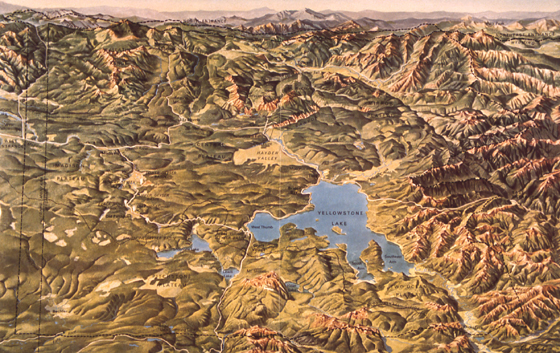
and in this NPS panorama of Yellowstone Park, the Teton range, with Jackson Lake showing just below it, is at the top:
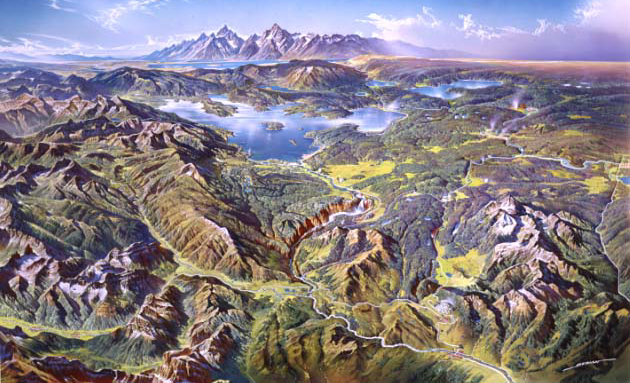
You can download a copy of the Yellowstone panorama above at:
https://npgallery.nps.gov/HFC/SearchResults?allFields=berann&allFieldsFormat=AllWords&collection=HFC+Cartography&view=list&PageSize=24
and enlarge as you want, to create another panorama. In the one below, the road from Grand Teton Park into Yellowstone Park (a narrow white line on the map) goes to the far right of Mount Sheridan and the left of Lewis Lake (on the far right hand side of the panorama).
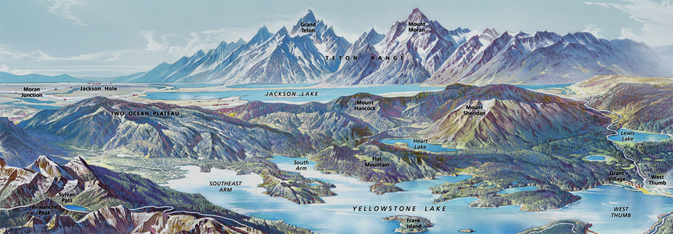
And then that white line (road) goes down to Grant Village and the West Thumb Geyser Basin, https://www.nps.gov/yell/planyourvisit/westthumbgrantvillage.htm
Then 17 miles (often over a half hour) across to the right to Old Faithful https://www.nps.gov/yell/planyourvisit/oldfaithfulvec.htm
The south border of Yellowstone is only 8 miles from the north border of Grand Teton.
At the entrance station, if you already have cash or Credit/Debit or a parks pass and photo ID of the person in your vehicle who owns the pass, out and ready to go, you will not hold up the rest of the sometimes long line of vehicles as much.
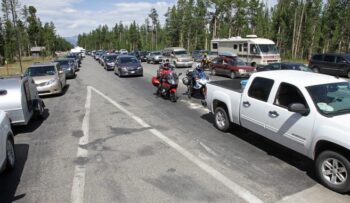
From the south border to West Thumb is 22 miles and then 17 miles to Old Faithful. This could easily be a one day visit ( with hikes, visitor centers) from Grand Teton. It’s possible to do the whole figure eight sightseeing loop of Yellowstone’s main road (the Grand Loop) in one day, but not advised. Cumulative mileages: Upper Loop 70 mi/113 km, Lower Loop 96 mi/155 km, Grand Loop 142 mi/229 km)
The NPS says: “The park speed limit is 45 mph (72 kph) unless posted slower. Icy and wet roads require extra attention. . . . Cyclists must ride single file. Drivers should pass no closer than 3 feet (1 m) to bicycles and roadside pedestrians.”
Expect traffic jams at entrance stations
and along the road when bison decide it is time to cross the road:
and traffic jams when people try to park just off the roadway (often illegally) and can’t get their vehicle far enough off the road, but take of to sightsee, get a photo, making it difficult for others to get by:
Expect people who ignore No Parking signs, making it difficult for people who park legally to back out of their parking space.
Another reason to only park in wide-enough paved turnouts along the road
is that if you park a vehicle in tall dry grass,
hot tailpipes can cause fine fuels to catch on fire.
Yellowstone has a page about parking, including busy times (you guessed it, often noonish to 4 p.m.)
https://www.nps.gov/yell/planyourvisit/parking.htm
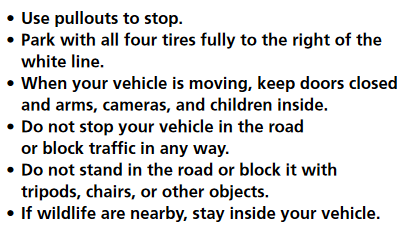
Yellowstone safety basics really worth reading:
https://www.nps.gov/yell/planyourvisit/safety.htm
Lots of travel companies say you can see wolves in Yellowstone.
Sightings are actually rare and from quite a distance.
From a 2018 wolf report: “There were at least 80 wolves in 9 packs (7 breeding pairs) living primarily in Yellowstone National Park (YNP) at the end of December 2018.” “As of January 2020, there are at least 94 wolves in Yellowstone park. Eight packs were noted.”
According to Yellowstone Forever, as of 2021 “31 wolves were reintroduced to Yellowstone National Park between 1995 and 1997, and today, at least 94 wolves in 8 unique packs thrive in the park”
https://www.yellowstone.org/
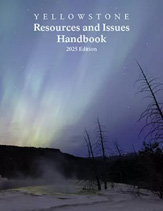 In the Yellowstone Resources and Issues Handbook “As of January 2025, at least 108 live primarily in the park.” https://www.nps.gov/yell/learn/resources-and-issues.htm
In the Yellowstone Resources and Issues Handbook “As of January 2025, at least 108 live primarily in the park.” https://www.nps.gov/yell/learn/resources-and-issues.htm
___________________________________
Wolf pack territories in Grand Teton and Yellowstone National Parks and wolf watching tips includes links to years of park service wolf reports.
Yellowstone National park had this in the Yellowstone Visitor Guide:
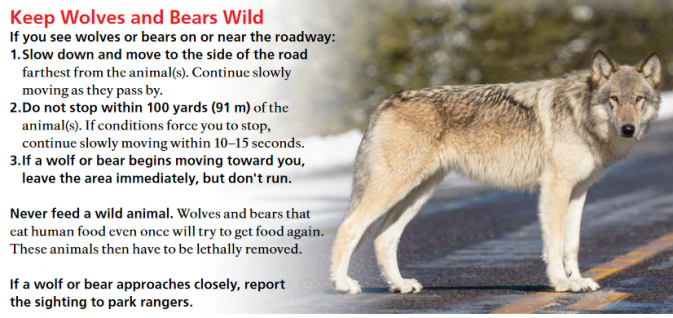
And see the 2018 Yellowstone Bird Report. Many of the same birds are in Grand Teton National park. See pictures and links to bird calls.
2018 Bear Management Annual Report.
Yellowstone Science https://www.nps.gov/subjects/yellowstonescience/yellowstone-science-archive.htm
These photos are by Quang-Tuan Luong/terragalleria.com, all rights reserved.
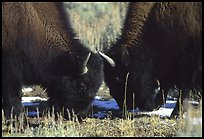
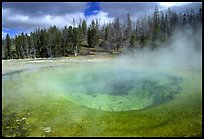
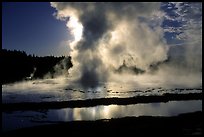
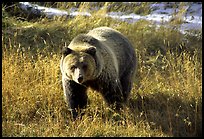
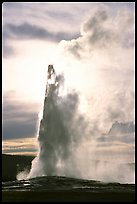
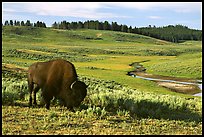
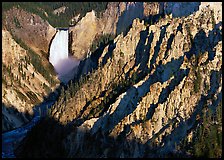
From the top you can see (far off) geysers erupting.
At the bottom center of the photo below you can see hikers on the trail that is mostly a wide path.
Here, a NASA photo showing Mount Washburn, and the upper and lower falls on the Yellowstone river.
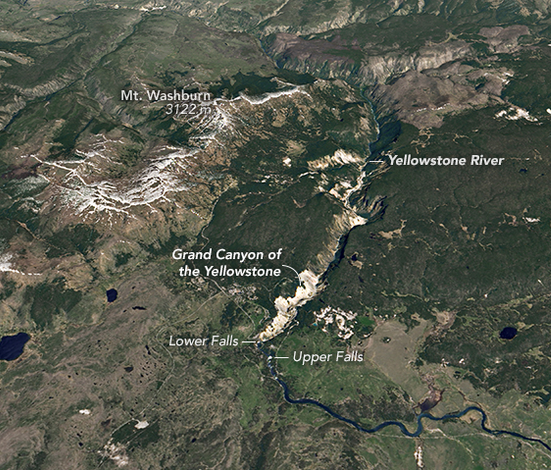
Here, a view of Mount Washburn from the Hellroaring Creek trail in the Absaroka Beartooth Wilderness:
Here, the webcam at the fire lookout at the top of Mount Washburn (the “webcam is located inside the living quarters on the top floor and looks out to the northeast”):
https://www.nps.gov/media/webcam/view.htm?id=81B46891-1DD8-B71B-0B6575944D4DECD5
and a webcam with a “south-facing view of the north-central part of the park. During summer, the webcam is often re-positioned by the fire lookout.”
https://www.nps.gov/media/webcam/view.htm?id=81B4689E-1DD8-B71B-0B8741319EA29FD3

___________________________________________
Grand Prismatic Spring in Yellowstone is
200-330 feet in diameter and more than 121 feet deep. You could be one of the people on the boardwalks you see in upper part of the photo below, or you can do a short hike to a viewpoint and get this photo (OR you could have someone in your group do the hike and take a photo of your group down on the boardwalk).

NPS photo: Aerial view of Grand Prismatic (upper right) and Excelsior Geyser Crater (lower left)
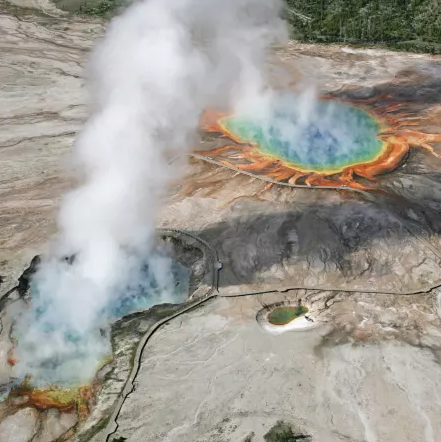
Grand Prismatic Spring, (in Midway Geyser Basin) is the largest hot spring in the United States, and the third largest in the world.
Video of of Grand Prismatic Spring, with links to other Yellowstone videos:
https://www.nps.gov/yell/learn/photosmultimedia/vl_grandprismatic.htm
___________________________________________
Planning a visit to Yellowstone is at:
http://www.nps.gov/yell/planyourvisit/index.htm
with links to maps and a complete park trip planner. At the maps section you can click on individual section maps, many of which have online tours. 
Video of geyser eruption
https://www.nps.gov/media/video/view.htm?id=8EB6716F-D62C-4D5A-9641-1F88AACA5ACA
West Thumb Geyser Basin https://www.nps.gov/yell/learn/nature/west-thumb-geyser-basin.htm is another of our favorites:
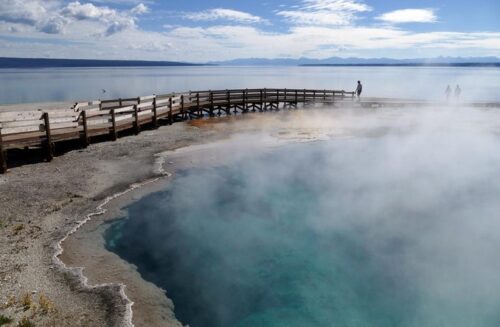
__________________
below: Norris Campground:
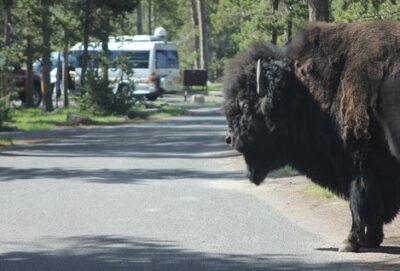
Bison sometimes wander through some of the Yellowstone National Park campgrounds (notice the size of these two bison in comparison to the tents):
below: Bridge Bay Campground

See what people were doing before a bison charged them.
Where can you find bison herds in Yellowstone? The NPS map below shows bison July-August breeding range (in dark red), Sept-May fall-winter range (orange). Bison movement routes are shown with red arrows:
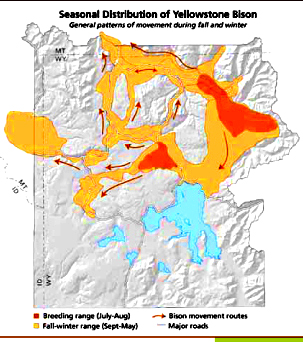
__________________
The Yellowstone Park website also has links to online nature tours, geology, at:
http://www.nps.gov/yell/learn/nature/index.htm
The Yellowstone park site has mini-videos well worth watching:
“Park regulations state that visitors must stay more than 100 yards away from bears and 25 yards away from other wildlife. Many visitors see large wild animals that seem tame and therefore approach far closer than they should. These videos are intended to convince everyone that it is unwise to approach wild animals even if they seem tame.” One shows an elk redoing the paint job on a Cadillac.

Watch the videos at: http://www.nps.gov/yell/learn/photosmultimedia/safetyvideos.htm
(When we watched them they took quite awhile longer than advertised to watch, as they had to rebuffer a few times, but they are worth it. No, we’ve never gotten even close to having anything like this happen.)
The NPS offered this:
“Since Yellowstone was established in 1872, eight people have been killed by bears in the park. More people in the park have died from drowning (121 incidents), burns (after falling into hot springs, 21 incidents), and suicide (26 incidents) than have been killed by bears. To put it in perspective, the probability of being killed by a bear in the park (8 incidents) is only slightly higher than the probability of being killed by a falling tree (7 incidents), in an avalanche (6 incidents), or being struck and killed by lightning (5 incidents).”
Every year people are badly burned when they fall into thermal features in Yellowstone.

Most of this is due to not staying on the boardwalks, or playing/running on the board walks, or not looking and respecting instructions on warning signs:.
The boardwalks are narrow and do not always have railings. Running, playing or bringing dogs on these would be dangerous:
A park news release said: “Yellowstone park visitors are reminded that for their own safety it is important to stay on boardwalks and designated trails while viewing all thermal features in the park. Scalding water underlies thin, breakable crusts; many geyser eruptions are unpredictable, and many thermal features are near or above boiling temperatures. Boardwalks and trails help protect park visitors and prevent damage to delicate formations.”
January 9, 2020
MAMMOTH HOT SPRINGS, WY – Two men were recently sentenced for trespassing on the cone of Old Faithful Geyser, a closed thermal area. Eric Schefflin, 20, of Lakewood, Colorado, and Ryan Goetz, 25, of Woodstock, New York, appeared in court on December 5, 2019, before U.S. Magistrate Judge Mark Carman at the Yellowstone Justice Center in Mammoth Hot Springs, Wyoming.
Schefflin and Goetz pleaded guilty to the violation of thermal trespass. On September 10, 2019, at about 8:30 p.m., employees and visitors witnessed two individuals walking on the cone of Old Faithful Geyser and reported it to park dispatch. A ranger contacted and cited Schefflin and Goetz.
Sentencing for each included:
10 days of incarceration
$540 in restitution
Five years of unsupervised probation
Five year ban from Yellowstone National Park
“Visitors must realize that walking on thermal features is dangerous, damages the resource, and illegal. Law enforcement officers take this violation seriously. Yellowstone National Park also appreciates the court for recognizing the impact thermal trespass can have on these amazing features,” said Chief Ranger Sarah Davis.
read more incidents at:
fatal, near fatal or close call incidents/accidents in camping, backpacking, climbing and mountaineering
“Reach into your pocket for your camera, and out comes a stray wrapper along with it. A brief gust of wind, and say bye to your hat. Most people know not to throw things into hot springs, but many of the impacts we’re seeing seem to be accidental. So, hold onto your hats!” – Geothermal Monitor Megan Norr (who cleans litter and gear out of geysers).
Is there a bulge under Yellowstone Lake?
What causes earthquake swarms at Yellowstone?
Frequently asked questions about recent findings at various Yellowstone locations is at:
https://www.usgs.gov/observatories/yvo/news/yvo-2023-annual-report-has-hit-streets
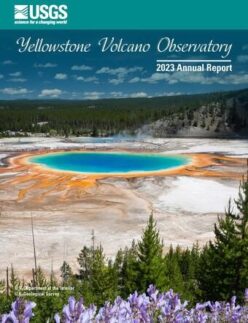
and see:
https://www.usgs.gov/observatories/yvo
“QUESTION: Do scientists know if a catastrophic eruption is currently imminent at Yellowstone?
ANSWER: There is no evidence that a catastrophic eruption at Yellowstone is imminent, and such events are unlikely to occur in the next few centuries. Scientists have also found no indication of an imminent smaller eruption of lava.
The Yellowstone caldera is in about the center of the park, including the northern part of Yellowstone Lake. Picture a semi-circle encompassing the area from Madison to Norris to a bit east of Canyon Village, then south to east of Fishing Bridge and Bridge Bay then continue west to south of Grant Village and west of Old Faithful then finally back up to Madison. If you camp or stay in hotel at Grant Village, Old Faithful or Canyon Village you have literally slept on a caldera.
This display about the caldera details the cubic miles of material erupted by the Yellowstone Super Volcano in the last big eruption 164,00 million years ago versus Mount St. Helens and Crater Lake.”
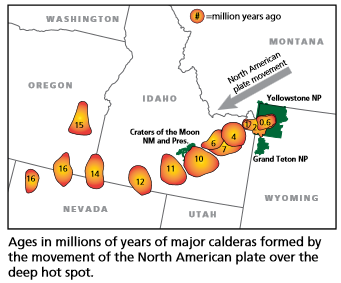
The park has an average of around 1,600 earthquakes a year. From January 17 to 22, 2010, a swarm of quakes numbered over 1,000, ten of them magnitude 3.0 or greater (one of those 3.8). Quakes under 3.0 are usually not felt by people.
Was that shaking I felt an earthquake? Intermountain west earthquakes, including
Montana, Idaho, Wyoming, Nevada, Utah, Colorado, Arizona and New Mexico, are monitored, with a map of recent earthquakes in the last 2 hours, last 2 days, last week, with locations, magnitude, times of occurrence, at
https://quake.utah.edu/earthquake-center/quake-map
There are places out in Lake Yellowstone where vents have been documented:
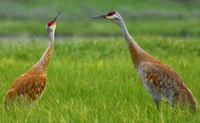
The birds with the red on their head above are Sandhill Cranes, perhaps the ones we look most forward to hearing, and if we are lucky, see dancing with each other.
Grand Teton National Park birds includes Bald Eagle, Canada Goose, Golden Eagle, Great Blue Heron, Great Gray Owl, Harlequin Duck, Loon, Magpie, Northern Flicker (woodpecker), Osprey, Pelican, Ouzel, Peregrine Falcon, Raven, Sandhill Crane, Steller’s Jay and Trumpeter Swan, with links to calls / songs from most of them to listen to.

Live shots of Old Faithful geyser (in Yellowstone) and the Upper Geyser Basin,
http://www.nps.gov/yell/learn/photosmultimedia/webcams.htm
Sometimes you can see Old Faithful geyser and another geyser erupting at the same time:
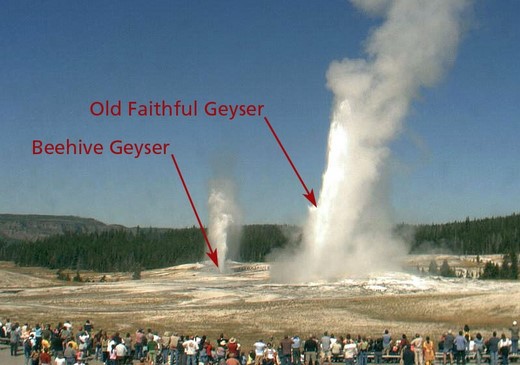
The park offers this photo of the locations of all the major geysers viewable from the Old Faithful Webcam:
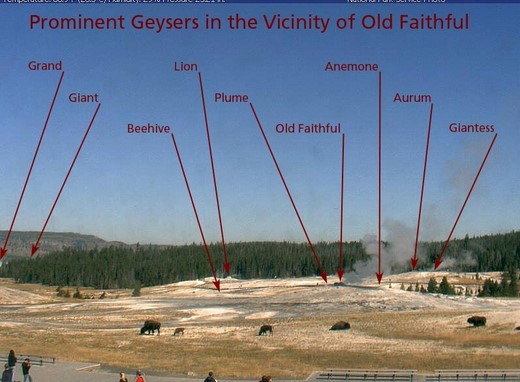
Old Faithful erupts on the average every 60 to 110 minutes, for 1 1/2 to 5 minutes, with an average height of 130 feet. Scroll down at https://www.nps.gov/yell/learn/nature/hydrothermal-features.htm for the next eruption prediction. “The famous geyser currently erupts around 17 times a day and can be predicted with a 90 percent confidence rate within a 10 minute variation.” “After each Old Faithful eruption, rangers predict when the next one will be. From over 100 years of recording data, we know if an eruption is longer than 3 minutes, it will be 95 (+/- 10) minutes until the next eruption. If it’s under 3 minutes, then it will be 66 (+/- 10) minutes until the next eruption.”
Our favorite memory of an Old Faithful eruption was at night with light from a full moon and lightning from a thunderstorm in the background.
Plan to have enough time to find parking and get to where you can see the eruption:

Ansel Adams took this photo of Old Faithful at a time of day most people are not watching the eruption: (photo courtesy of the National Archives)
The NPS estimates the amount of water expelled during one eruption ranges from 3,700 to 8,400 gallons (14,000 to 32,000 liters), equivalent to 3 weeks of water usage for the average American household.
As usual, you can miss the crowds if you are out early. (above and below NPS photos of a typical crowd waiting for an eruption of Old Faithful Geyser)
If you are out early you have a better chance of getting the photo you want.
and maybe see park residents using the boardwalk:
Elsewhere in the nearby Upper Geyser Basin,
https://www.nps.gov/yell/planyourvisit/exploreoldfaithful.htm
get up in the middle of the night and you might be lucky enough to get a photo as good as this one of Castle Geyser and the Milky Way from the NPS:
You can hike (1.6-mile (2.6-kilometer round trip) to where this next photo was taken:
https://www.nps.gov/thingstodo/yell-trail-observation-point.htm
photo used with permission from Ron Niebrugge: http://www.wildnatureimages.com/

Old Faithful Hotel is the one you see in the picture.
And here, another photo, from a slightly different direction, of the Old Faithful geyser and hotel:

Info about the hotels and cabins in Yellowstone is at:
http://www.ynp-lodges.com/
Yellowstone has many general stores with groceries and souvenirs as well as restaurants serving at least burgers. Below, the Canyon, Lake and Grant Village Stores:

The Yellowstone Park newspaper, that you get a copy of when you enter the park, offered a map of cell phone coverage (summer 2025), that said “Approximate Cell Phone Coverage: Verizon all shaded areas, AT&T Canyon to Tower, Union Telecom Grant Old Faithful, Mammoth.”
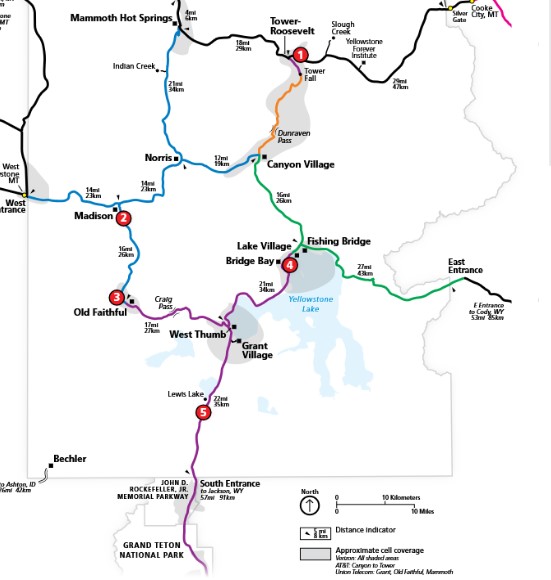
 Was that a black bear or a grizzly, a coyote or a wolf or a fox we just saw?
Was that a black bear or a grizzly, a coyote or a wolf or a fox we just saw?
 Rocky Mountain mammal size comparisons has photos and comparisons of beavers, squirrels, pika, marmot, elk, moose, bison, fox, coyote, wolf, golden-mantled ground squirrel, chipmunk, Red Squirrel (also known as) Chickaree, Unita Ground squirrels, bobcat, lynx, mountain lion (cougar), pine marten, mountain goats, bighorn sheep, pronghorn, grizzly and black bears, tundra swan, trumpeter swan, adult and juvenile Bald Eagles.
Rocky Mountain mammal size comparisons has photos and comparisons of beavers, squirrels, pika, marmot, elk, moose, bison, fox, coyote, wolf, golden-mantled ground squirrel, chipmunk, Red Squirrel (also known as) Chickaree, Unita Ground squirrels, bobcat, lynx, mountain lion (cougar), pine marten, mountain goats, bighorn sheep, pronghorn, grizzly and black bears, tundra swan, trumpeter swan, adult and juvenile Bald Eagles.
According to a Yellowstone fact sheet
WILDLIFE
photo below used with permission from the photographer Ron Niebrugge http://www.wildnatureimages.com/
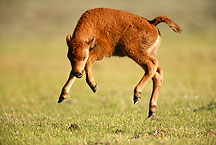
7 species of native ungulates (this includes 15,000 to 20,000 elk in summer, more than 500 moose, more than 2,000 mule deer).
2 species of bears (500 to 650 black bears, 280 to 610 grizzlies)
Approximately 50 species of other mammals, including 171 wolves and 20-35 cougars
311 recorded species of birds (148 nesting species)
18 species of fish (6 non-native)
6 species of reptiles
4 species of amphibians
5 species protected as “threatened or endangered”
Threatened: bald eagle, grizzly bear, lynx
Endangered: whooping crane, gray wolf
FLORA
8 species of conifers
Approximately 80% of forest is comprised of lodgepole pine
More than 1,700 species of native vascular plants
More than 170 species of exotic (non-native) plants
186 species of lichens
GEOLOGY
An Active Volcano
Approximately 2,000 earthquakes annually
Approximately 10,000 thermal features
More than 300 geysers
One of the world’s largest calderas, measuring 45 by 30 miles (72 by 48 km)
One of the world’s largest petrified forests
Approximately 290 waterfalls, 15 ft. or higher, flowing year-round
Tallest waterfall: Lower Falls of the Yellowstone River at 308 ft. (94 m)
Which is the best place in Yellowstone to watch wildlife, Hayden Valley or Lamar Valley?
Teton Science School gives us this answer:
Wolves: Lamar valley
Grizzly bears : Hayden Valley or Lamar Valley are equally good.
Birds: “For bird photography, Lamar has a slight edge over Hayden during nesting season, but for the real bird-nerds, head to Hayden Valley.”
Bison: “For sheer year-round numbers and just a teasing hint at the rich bison-covered plains seen by Lewis and Clark, the win goes to Lamar.”
Moose: “There is almost no moose food in Hayden Valley – no willows or cottonwoods along the river, no aspens on the hillside. Lamar Valley has seen an increase in moose sightings over the last decade as the deciduous trees and shrubs grow back after decades of overbrowsing by overpopulated elk. Moose are one of the most heat-sensitive animals in the Park, so look for moose early in the morning or on cold rainy days.”
Elk: Lamar
Lamar Valley . . . “is home to bighorn sheep, pronghorn (in the snow-free months), deer, and the non-native mountain goat”

The diary of artist Thomas Moran is at:
http://www.nps.gov/yell/historyculture/thomasmoransdiary.htm

See: https://www.nps.gov/thingstodo/yell-grand-canyon-of-the-yellowstone.htm

Each visitor center is different. At each you can get boat and backpack permits. (In previous years the boat permit you bought in Grand Teton was okay to use in Yellowstone, but more recently you need a second permit for Yellowstone.)
and also pick up the paperwork to earn your Yellowstone Junior Ranger badge, which you will want to start at the beginning of your Yellowstone visit.
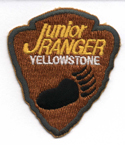
At Canyon we really enjoyed the projects to earn our Yellowstone Young Scientist award:
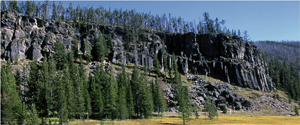
In the New York Times we read:
Obsidian Cliff: Humanity’s Tool Shed for the Last 11,500 Years
”X-ray technology has allowed researchers a glimpse at the reaches of the Yellowstone landmark’s prized stone and its importance to Indigenous people.. . .
. . . Obsidian is among the most prized tool stones in the world, and this particular deposit, nearly 100 feet thick, is exceptional because of its continual use by Indigenous people since the last ice age. Over the last 11,500 years or so, the stone has been fashioned into deadly knives, razor-sharp spear points, darts for atlatls, or spear-throwers, and arrowheads.. .
. . .The geochemical fingerprint of the cliff’s volcanic glass has been found all around the West, as well as in Canada. Area tribes “all knew about it, all the archaeological sites in Montana that are important have some form or another of obsidian, and most of it comes from this place — Obsidian Cliff,” Dr. MacDonald said. “All of the tribes in Montana, Wyoming and Idaho were going out of their way to get it.”
https://www.nytimes.com/2023/03/20/science/yellowstone-indigenous-people-obsidian.html
https://www.nps.gov/features/yell/kiosk/weather.html
________________________________________________
Your safety in grizzly bear territory.
while also providing you a safe and enjoyable experience.
The following activities are prohibited in Yellowstone:
Willfully remaining near or approaching wildlife, including nesting birds, within any distance that disturbs or displaces the animal.
Hunting or feeding wildlife.
Traveling off boardwalks or designated trails in hydrothermal areas.
Throwing anything into thermal features.
Swimming in hot springs.
Removing or possessing natural or cultural resources (such as wildflowers, antlers, rocks, and arrowheads).
Leaving detachable side mirrors attached when not pulling trailers.
Traveling off-road by vehicle or bicycle.
Camping outside of designated areas.
Spotlighting wildlife (viewing with lights).
Imitating elk calls or using buglers. Imitating wolf howls.
Using electronic equipment capable of tracking wildlife
Launching, landing, or operating unmanned aircraft (drones) on lands and waters
.
Smoking is prohibited in geyser basins or on trails. There is no smoking in buildings or within 25 feet of building entrances.”
https://www.nps.gov/yell/learn/management/lawsandpolicies.htm
A list of books you can download for free and read in advance of a Yellowstone or Grand Teton visit are at Recommended Reading
See also: animal sign comparisons
(how to use tracks and scat to distinguish species)
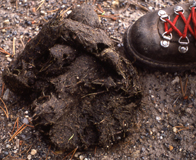
Please do not handle scat. Wolf scat, for example, can transmit tapeworm eggs to humans.
Many people think of trees the shape of the ones shown below as “pine” trees,
but only one of them is actually a pine tree and we see it in Yosemite rather than in Yellowstone or on the Grand Teton Trip. If you are interested in learning more, see tree identification in Grand Teton Park.
There is more info about the De Anza College Outdoor Club trip at:
Grand Tetons recommended reading
includes a link to The Journals of Lewis and Clark
Clark: “…bison were so numerous and loud that the men had difficulty sleeping.”
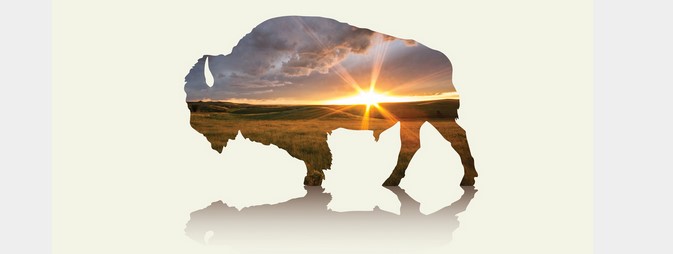
(Alanna on Montana sign photo by Mark Nevill)
![]()
——————————————————————-
The author of this webpage, (written as a reading assignment for my students), does not give any warranty, expressed or implied, nor assume any legal liability or responsibility for the accuracy, completeness, or usefulness of any information, product, or process included in this website or at websites linked to or from it. Users of information from this website assume all liability arising from such use.
